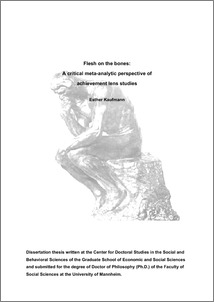|
Flesh on the bones : A critical meta-analytic perspective of achievement lens studies
Kaufmann, Esther
![[img]](https://madoc.bib.uni-mannheim.de/style/images/fileicons/application_pdf.png)  Vorschau |
|
PDF
DissertationKaufmannFleshonthebones.pdf
- Veröffentlichte Version
Download (3MB)
|
|
URL:
|
https://ub-madoc.bib.uni-mannheim.de/2892
|
|
URN:
|
urn:nbn:de:bsz:180-madoc-28925
|
|
Dokumenttyp:
|
Dissertation
|
|
Erscheinungsjahr:
|
2010
|
|
Titel einer Zeitschrift oder einer Reihe:
|
None
|
|
Ort der Veröffentlichung:
|
Mannheim
|
|
Verlag:
|
Universität
|
|
Hochschule:
|
Universität Mannheim
|
|
Gutachter:
|
Wittmann, Werner W.
|
|
Datum der mündl. Prüfung:
|
30 September 2009
|
|
Sprache der Veröffentlichung:
|
Englisch
|
|
Einrichtung:
|
Fakultät für Sozialwissenschaften > Psychologische Methodenlehre u. Diagnostik (Meiser 2009-)
Außerfakultäre Einrichtungen > GESS - CDSS (SOWI)
|
|
Fachgebiet:
|
150 Psychologie
|
|
Fachklassifikation:
|
THES_SOZ:
Evaluation Urteilsbildung ,
|
|
Normierte Schlagwörter (SWD):
|
Metaanalyse , Brunswik, Egon , Entscheidung , Psychometrie , Genauigkeit
|
|
Freie Schlagwörter (Deutsch):
|
Linsenmodell , Tucker'sche Linsengleichung , psychometrische Meta-Analyse , Urteilsgenauigkeit
|
|
Freie Schlagwörter (Englisch):
|
Social Judgment Theory , lens model equation , psychometric meta-analysis , judgment achievement , idiographic vs. nomothetic approach
|
|
Abstract:
|
In the evaluation work on judgment and decision-making meta-analysis is often applied (see Karelaia & Hogarth, 2008; Grove et al., 2000). In all these studies the so-called bare-bones meta-analysis is used, the psychometric meta-analysis would be more accurate (see Wittmann, 1985). Hence, in my thesis I took lens studies on judgment achievement to reveal the success of psychometric evaluation and compare them with previous bare-bones meta-analysis (Kaufmann & Athanasou, 2009). Our work clearly shows that without such an analysis judgment achievement and the underlying lens components are underestimated and their heterogeneity overestimated or in other words, that flesh is needed on the bones to accurately evaluate judgment and decision-making research. Consequently, also the success of expert model make-up on bare-bones meta-analyzed lens model indexes is not adequately estimated (see Camerer, 1981; Karelaia & Hogarth, 2008).
|
|
Übersetzter Titel:
|
Urteilsgenauigkeiten in Linsenmodell-Studien : Eine kritische meta-analytische Perspektive
(Deutsch)
|
|
Übersetzung des Abstracts:
|
Zahlreiche Studien bestimmten die Urteilsgenauigkeit im Rahmen des Linsenmodells (Brunswik, 1952) mit der Tucker'schen Gleichung (1964). Diese Studien wurden in Meta-Analysen evaluiert um herauszufinden a) wie genau einzelne Personen in unterschiedlichen Aufgaben urteilen, b) ob sich die Urteilsgenauigkeit in Fachgebieten unterscheidet, c) ob Experten genauer als Laien urteilen und d) ob Experten-Modelle genauer sind. Bisher wurden nur "bare bones" Meta-Analysen verwendet, obwohl psychometrische Meta-Analysen wegen zusätzlicher Artefaktkorrekturen genauer sind. Unsere psychometrische Meta-Analyse basiert auf 1151 Urteilsgenauigkeiten in 49 unterschiedlichen Aufgaben von 5 Fachgebieten. Obwohl unterschiedliche Korrekturstrategien angewendet wurden, zeigte sich sogar mit nur einer konservativen Schätzung über alle Studien hinweg a) eine erhöhte Urteilsgenauigkeit (r
(Deutsch)
|
 | Das Dokument wird vom Publikationsserver der Universitätsbibliothek Mannheim bereitgestellt. |
 Suche Autoren in Suche Autoren in
Sie haben einen Fehler gefunden? Teilen Sie uns Ihren Korrekturwunsch bitte hier mit: E-Mail
Actions (login required)
 |
Eintrag anzeigen |
|
|
